airbag MITSUBISHI MIRAGE 2015 6.G Owners Manual
[x] Cancel search | Manufacturer: MITSUBISHI, Model Year: 2015, Model line: MIRAGE, Model: MITSUBISHI MIRAGE 2015 6.GPages: 300, PDF Size: 43.44 MB
Page 3 of 300

Instruments and controls 1-1
1
Overview
N00100202629
Instruments and controls
Instrument cluster P.5-62
Hazard warning flasher switch P.5-77
Combination headlights and dimmer switch P.5-74 Turn-signal lever P.5-76 Front fog light switch (if so equipped) P.5-77
Wiper and washer switch P.5-78 Rear window wiper and washer switch P.5-79
Cruise control switches (if so equipped) P.5-52
Engine switch (if so equipped) P.5-13
Ignition switch (if so equipped) P.5-35
Active stability control (ASC) OFF switch P.5-50 Electric remote-controlled outside rearview mirror switch P.5-33
Supplemental restraint system (SRS)-air- bag (for driver) P.4-21, 4-27Horn switch P.5-81
Steering wheel height adjust- ment P.5-32
Steering wheel remote control switches (if so equipped) P.5-83, 7-37
Supplemental restraint system-driver’s knee airbag P.4-27
BK0212400US.book 1 ページ 2014年4月1日 火曜日 午後2時21分
Page 5 of 300
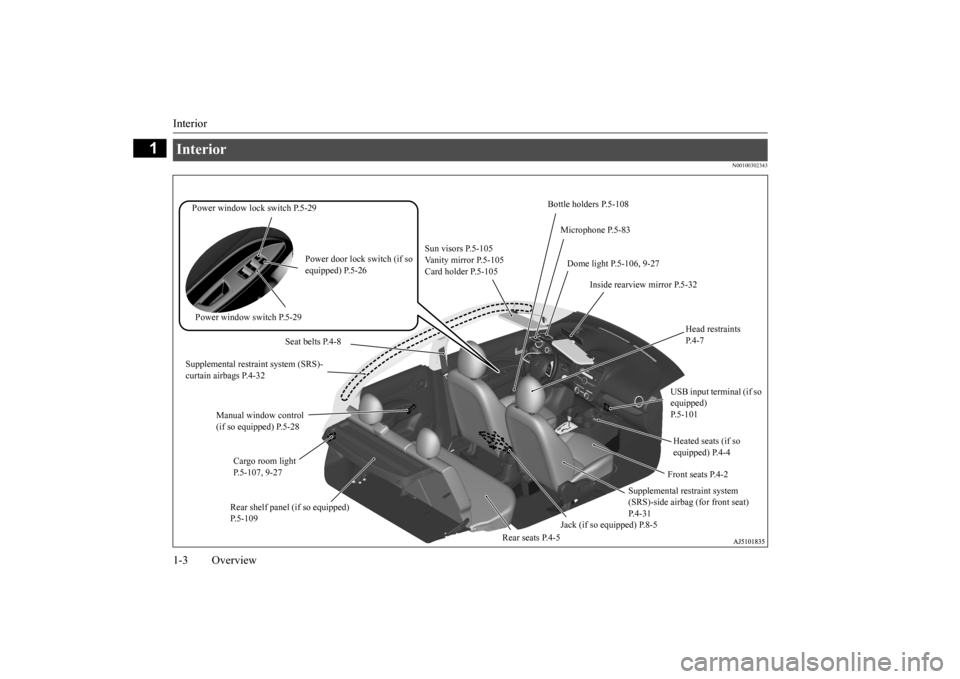
Interior 1-3 Overview
1
N00100302343
Interior
Bottle holders P.5-108
Power window lock switch P.5-29
Microphone P.5-83
Sun visors P.5-105 Vanity mirror P.5-105 Card holder P.5-105
Power door lock switch (if so equipped) P.5-26
Dome light P.5-106, 9-27
Inside rearview mirror P.5-32
Head restraints P. 4 - 7
Power window switch P.5-29
Seat belts P.4-8
Supplemental restraint system (SRS)- curtain airbags P.4-32
USB input terminal (if so equipped) P.5-101
Manual window control (if so equipped) P.5-28
Heated seats (if so equipped) P.4-4
Cargo room light P.5-107, 9-27
Front seats P.4-2
Supplemental restraint system (SRS)-side airbag (for front seat) P.4-31
Rear shelf panel (if so equipped) P.5-109
Jack (if so equipped) P.8-5
Rear seats P.4-5
BK0212400US.book 3 ページ 2014年4月1日 火曜日 午後2時21分
Page 12 of 300
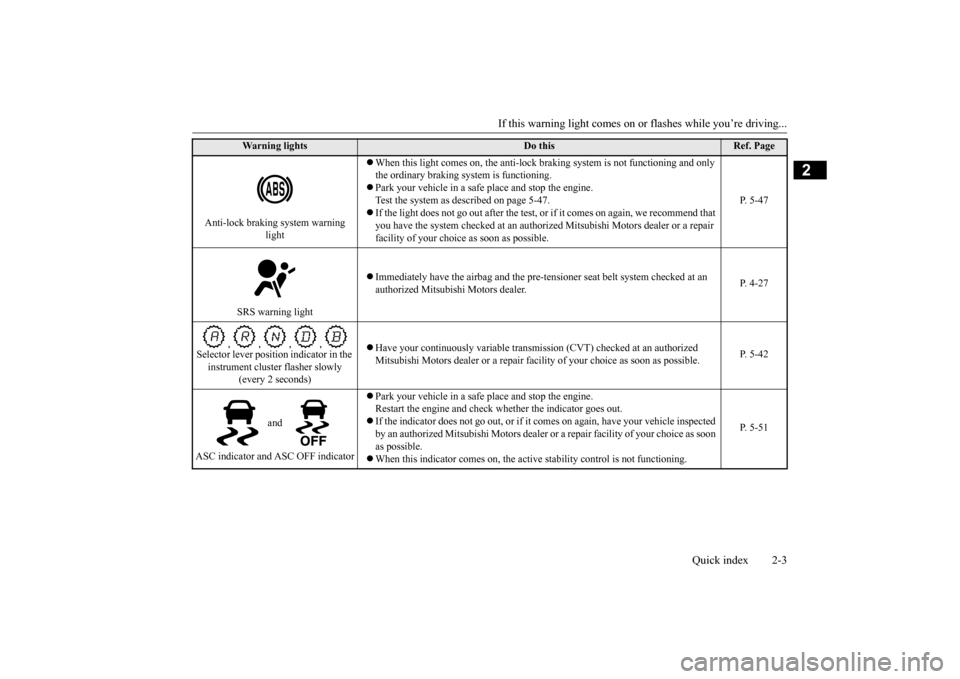
If this warning light comes on or
flashes while you’re driving...
Quick index 2-3
2
Anti-lock braking system warning
light
When this light comes on,
the anti-lock braking system
is not functioning and only
the ordinary braking system is functioning. Park your vehicle in a safe
place and stop the engine.
Test the system as described on page 5-47. If the light does not go out after
the test, or if it comes on
again, we recommend that
you have the system checked at an authorized
Mitsubishi Motors dealer or a repair
facility of your choice
as soon as possible.
P. 5-47
SRS warning light
Immediately have the airbag and the pre-te
nsioner seat belt sy
stem checked at an
authorized Mitsubishi Motors dealer.
P. 4-27
Selector lever position indicator in the instrument cluster flasher slowly
(every 2 seconds)
Have your continuously variable transmis
sion (CVT) checked at an authorized
Mitsubishi Motors dealer or
a repair facility of your
choice as soon as possible.
P. 5-42
and
ASC indicator and ASC OFF indicator
Park your vehicle in a safe
place and stop the engine.
Restart the engine and check
whether the indicator goes out.
If the indicator does not go out, or if it
comes on again, have
your vehicle inspected
by an authorized Mitsubishi Motors dealer or
a repair facility of your choice as soon
as possible. When this indicator comes on, the activ
e stability control is not functioning.
P. 5-51
Wa rn in g l ig h t s
Do this
Ref. Page
BK0212400US.book 3 ページ 2014年4月1日 火曜日 午後2時21分
Page 24 of 300
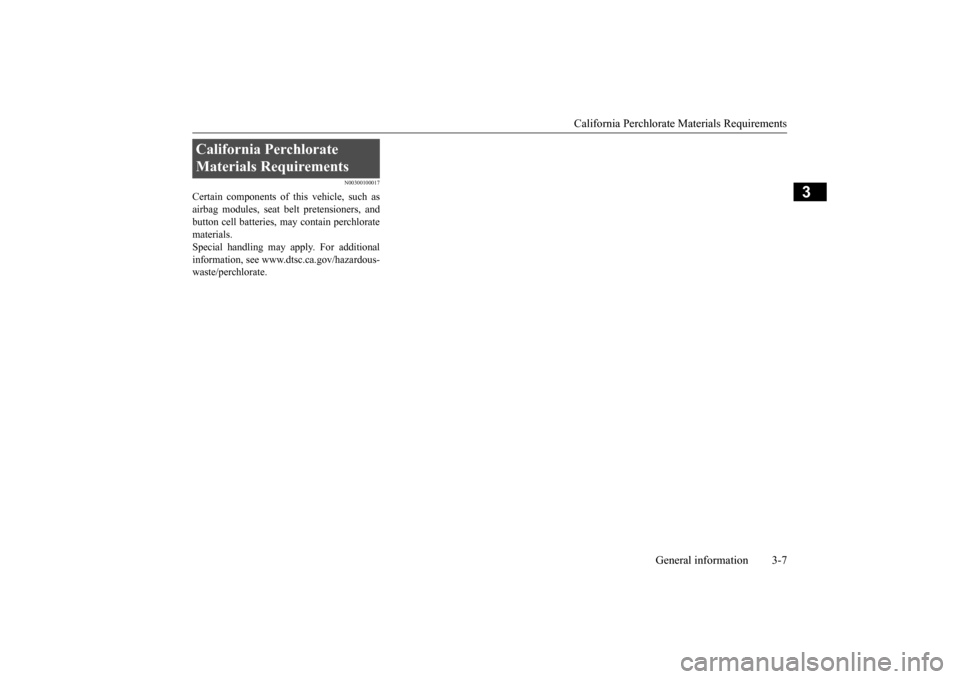
California Perchlorate Materials Requirements
General information 3-7
3
N00300100017
Certain components of this vehicle, such as airbag modules, seat belt pretensioners, and button cell batteries, ma
y contain perchlorate
materials. Special handling may apply. For additional information, see www.d
tsc.ca.gov/hazardous-
waste/perchlorate.California Perchlorate Materials Requirements
BK0212400US.book 7 ページ 2014年4月1日 火曜日 午後2時21分
Page 26 of 300
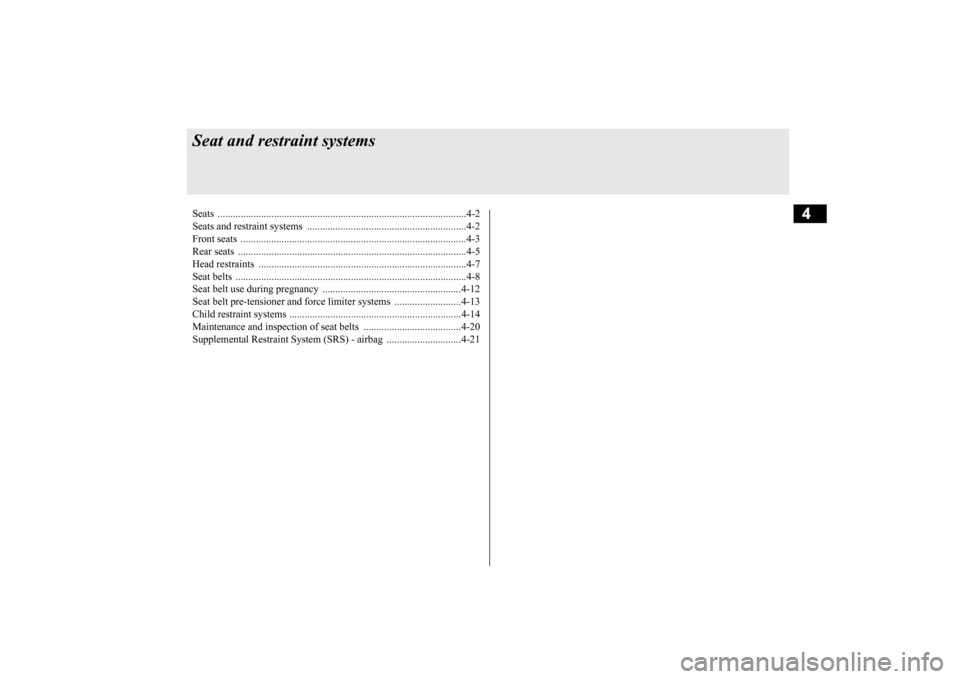
4
Seat and restraint systemsSeats .................................................................................................4-2 Seats and restraint systems ..............................................................4-2 Front seats ........................................................................................4-3Rear seats .........................................................................................4-5 Head restraints .................................................................................4-7 Seat belts ..........................................................................................4-8Seat belt use during pregnancy ......................................................4-12 Seat belt pre-tensioner and force limiter systems ..........................4-13 Child restraint systems ...................................................................4-14Maintenance and inspection of seat belts ......................................4-20 Supplemental Restraint Syst
em (SRS) - airbag ......
.........
.........
.....4-21
BK0212400US.book 1 ページ 2014年4月1日 火曜日 午後2時21分
Page 27 of 300
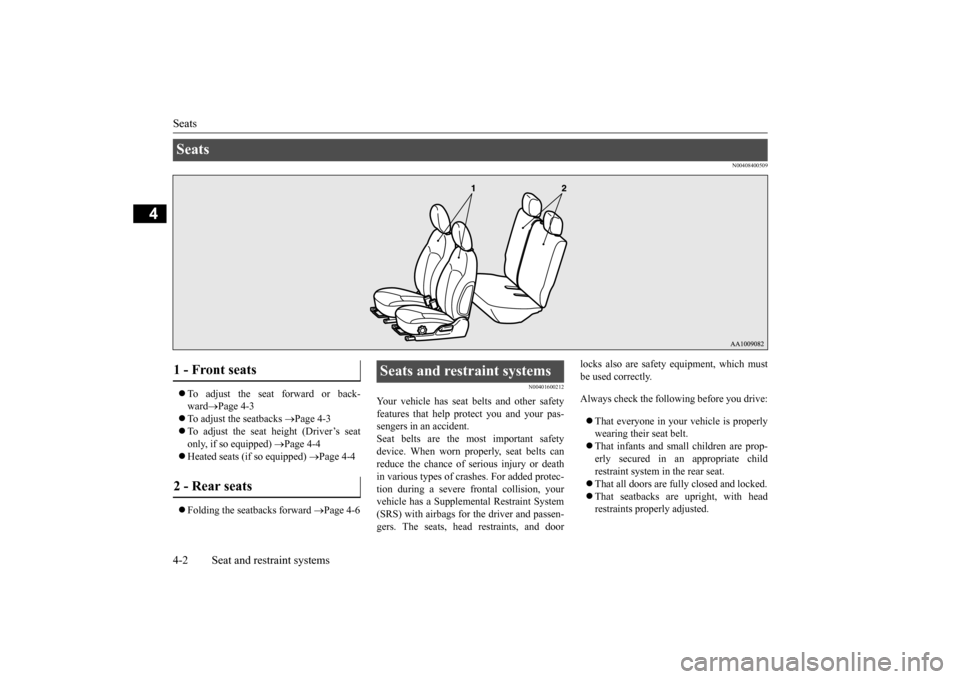
Seats 4-2 Seat and restraint systems
4
N00408400509
To adjust the seat forward or back- ward
Page 4-3
To adjust the seatbacks
Page 4-3
To adjust the seat height (Driver’s seat only, if so equipped)
Page 4-4
Heated seats (if so equipped)
Page 4-4
Folding the seatbacks forward
Page 4-6
N00401600212
Your vehicle has seat
belts and other safety
features that help
protect you and your pas-
sengers in an accident.Seat belts are the most important safety device. When worn properly, seat belts can reduce the chance of serious injury or deathin various types of cras
hes. For added protec-
tion during a severe fr
ontal collision, your
vehicle has a Supplemen
tal Restraint System
(SRS) with airbags for the driver and passen- gers. The seats, head restraints, and door
locks also are safety equipment, which must be used correctly. Always check the following before you drive: That everyone in your vehicle is properly wearing their seat belt. That infants and small children are prop- erly secured in an appropriate childrestraint system in the rear seat. That all doors are fully closed and locked. That seatbacks are upright, with head restraints properly adjusted.
Seats 1 - Front seats 2 - Rear seats
Seats and restraint systems
BK0212400US.book 2 ページ 2014年4月1日 火曜日 午後2時21分
Page 28 of 300
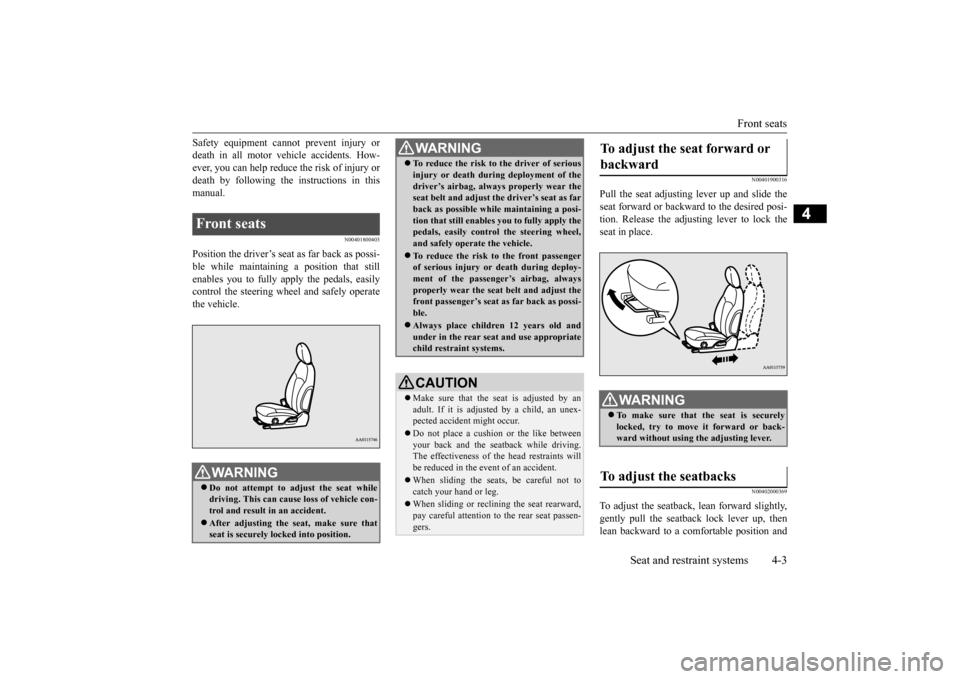
Front seats
Seat and restraint systems 4-3
4
Safety equipment cannot prevent injury or death in all motor ve
hicle accidents. How-
ever, you can help reduce the risk of injury or death by following the
instructions in this
manual.
N00401800403
Position the driver’s seat
as far back as possi-
ble while maintaining a position that still enables you to fully apply the pedals, easily control the steering wh
eel and safely operate
the vehicle.
N00401900316
Pull the seat adjusting lever up and slide theseat forward or backwa
rd to the desired posi-
tion. Release the adjusting lever to lock the seat in place.
N00402000369
To adjust the seatback,
lean forward slightly,
gently pull the seatback lock lever up, then lean backward to a comfortable position and
Front seats
WA R N I N G Do not attempt to adjust the seat while driving. This can cause loss of vehicle con- trol and result
in an accident.
After adjusting the se
at, make sure that
seat is securely locked into position.
To reduce the risk to the driver of serious injury or death during deployment of thedriver’s airbag, always
properly wear the
seat belt and adjust th
e driver’s seat as far
back as possible while maintaining a posi- tion that still enables
you to fully apply the
pedals, easily control the steering wheel, and safely operate the vehicle. To reduce the risk to the front passenger of serious injury or
death during deploy-
ment of the passeng
er’s airbag, always
properly wear the seat
belt and adjust the
front passenger’s seat as far back as possi- ble. Always place childr
en 12 years old and
under in the rear seat
and use appropriate
child restraint systems.CAUTION Make sure that the seat is adjusted by an adult. If it is adjusted by a child, an unex- pected accident might occur. Do not place a cushion
or the like between
your back and the seatback while driving. The effectiveness of the head restraints willbe reduced in the event of an accident. When sliding the seats, be careful not to catch your hand or leg. When sliding or reclining the seat rearward, pay careful attention to
the rear seat passen-
gers.WA R N I N G
To adjust the seat forward or backward
WA R N I N G To make sure that the seat is securely locked, try to move
it forward or back-
ward without using
the adjusting lever.
To adjust the seatbacks
BK0212400US.book 3 ページ 2014年4月1日 火曜日 午後2時21分
Page 34 of 300
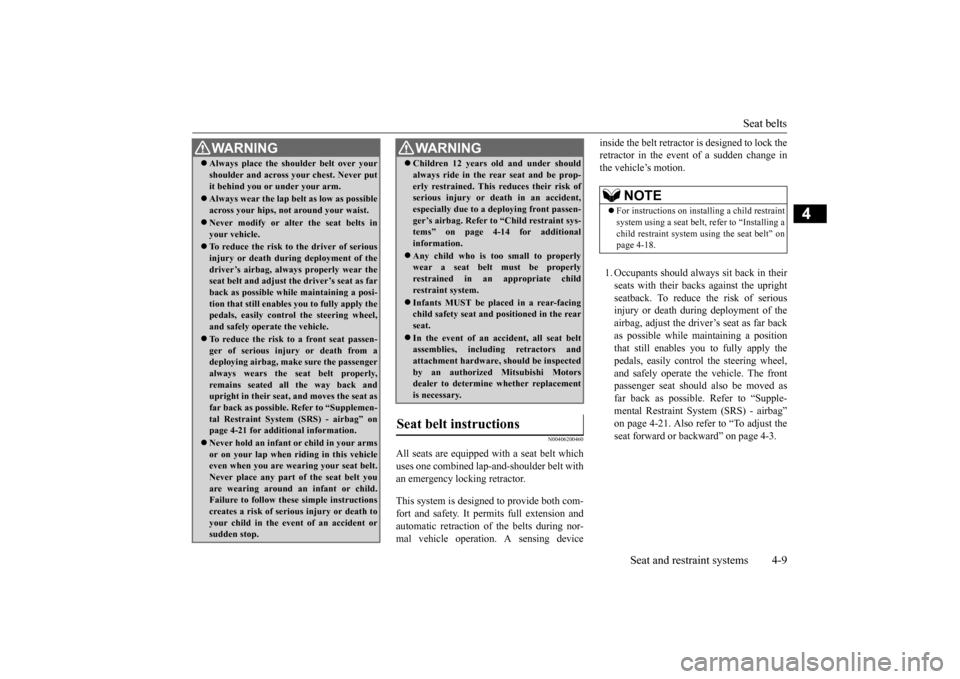
Seat belts
Seat and restraint systems 4-9
4
N00406200460
All seats are equipped with a seat belt which uses one combined lap-
and-shoulder belt with
an emergency locking retractor. This system is designed to provide both com- fort and safety. It pe
rmits full extension and
automatic retraction of the belts during nor- mal vehicle operation.
A sensing device
inside the belt retractor is designed to lock the retractor in the event of a sudden change inthe vehicle’s motion. 1. Occupants shoul
d always sit back in their
seats with their backs against the upright seatback. To reduce the risk of seriousinjury or death during deployment of the airbag, adjust the driver’s seat as far back as possible while maintaining a positionthat still enables you to fully apply the pedals, easily contro
l the steering wheel,
and safely operate the vehicle. The frontpassenger seat should
also be moved as
far back as possible. Refer to “Supple- mental Restraint System (SRS) - airbag”on page 4-21. Also refe
r to “To adjust the
seat forward or backward” on page 4-3.
Always place the shou
lder belt over your
shoulder and across you
r chest. Never put
it behind you or
under your arm.
Always wear the lap belt as low as possible across your hips, not around your waist. Never modify or alter the seat belts in your vehicle. To reduce the risk to the driver of serious injury or death durin
g deployment of the
driver’s airbag, always
properly wear the
seat belt and adjust th
e driver’s seat as far
back as possible while maintaining a posi-tion that still enables
you to fully apply the
pedals, easily control the steering wheel, and safely operate the vehicle. To reduce the risk to a front seat passen- ger of serious injury or death from adeploying airbag, make sure the passenger always wears the seat belt properly, remains seated all the way back andupright in their seat, and moves the seat as far back as possible. Refer to “Supplemen- tal Restraint System (SRS) - airbag” onpage 4-21 for additional information. Never hold an infant
or child in your arms
or on your lap when ri
ding in this vehicle
even when you are wearing your seat belt. Never place any part of the seat belt youare wearing around an
infant or child.
Failure to follow these simple instructions creates a risk of serious injury or death toyour child in the even
t of an accident or
sudden stop.WA R N I N G
Children 12 years ol
d and under should
always ride in the re
ar seat and be prop-
erly restrained. This reduces their risk ofserious injury or de
ath in an accident,
especially due to a deploying front passen- ger’s airbag. Refer to
“Child restraint sys-
tems” on page 4-
14 for additional
information. Any child who is too small to properly wear a seat belt
must be properly
restrained in an
appropriate child
restraint system. Infants MUST be plac
ed in a rear-facing
child safety seat and positioned in the rear seat. In the event of an ac
cident, all seat belt
assemblies, including retractors and attachment hardware, should be inspectedby an authorized
Mitsubishi Motors
dealer to determine whether replacement is necessary.
Seat belt instructions
WA R N I N G
NOTE
For instructions on installing a child restraint system using a seat belt
, refer to “Installing a
child restraint system
using the seat belt” on
page 4-18.
BK0212400US.book 9 ページ 2014年4月1日 火曜日 午後2時21分
Page 38 of 300
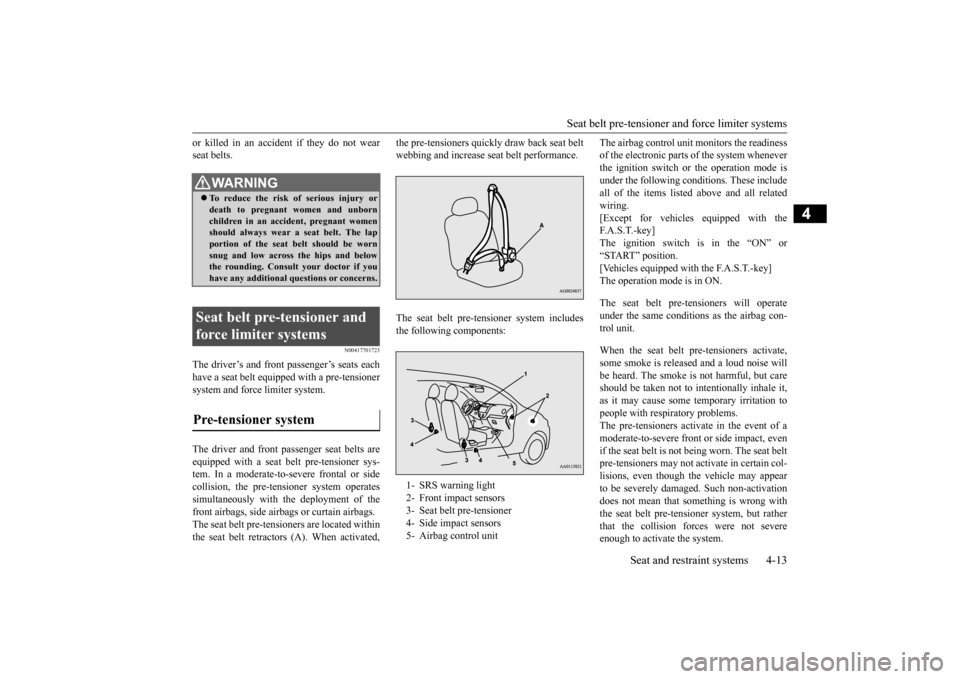
Seat belt pre-tensioner an
d force limiter systems
Seat and restraint systems 4-13
4
or killed in an accident if they do not wear seat belts.
N00417701723
The driver’s and front passenger’s seats eachhave a seat belt equippe
d with a pre-tensioner
system and force limiter system. The driver and front pa
ssenger seat
belts are
equipped with a seat
belt pre-tensioner sys-
tem. In a moderate-to-severe frontal or sidecollision, the pre-tens
ioner system operates
simultaneously with the deployment of the front airbags, side airbags or curtain airbags.The seat belt pre-tensioners are located within the seat belt retractors
(A). When activated,
the pre-tensioners quickly
draw back seat belt
webbing and increase se
at belt performance.
The seat belt pre-tens
ioner system includes
the following components:
The airbag control unit monitors the readiness of the electronic parts of the system wheneverthe ignition switch or the operation mode is under the following conditions. These include all of the items listed
above and all related
wiring. [Except for vehicles
equipped with the
F.A.S.T.-key] The ignition switch is in the “ON” or “START” position. [Vehicles equipped with the F.A.S.T.-key] The operation mode is in ON. The seat belt pre-tensioners will operate under the same conditions as the airbag con-trol unit. When the seat belt pr
e-tensioners activate,
some smoke is released and a loud noise will be heard. The smoke is
not harmful, but care
should be taken not to in
tentionally inhale it,
as it may cause some temporary irritation to people with respiratory problems.The pre-tensioners activate in the event of a moderate-to-severe front or side impact, even if the seat belt is not being worn. The seat beltpre-tensioners may not
activate in certain col-
lisions, even though the vehicle may appear to be severely damage
d. Such non-activation
does not mean that something is wrong with the seat belt pre-tensioner system, but rather that the collision fo
rces were not severe
enough to activate the system.
WA R N I N G To reduce the risk of serious injury or death to pregnant women and unborn children in an accident, pregnant women should always wear
a seat belt. The lap
portion of the seat belt should be worn snug and low across the hips and below the rounding. Consult your doctor if youhave any additional qu
estions or concerns.
Seat belt pre-tensioner and force limiter systems Pre-tensioner system
1- SRS warning light 2- Front impact sensors 3- Seat belt pre-tensioner 4- Side impact sensors 5- Airbag control unit
BK0212400US.book 13 ページ 2014年4月1日 火曜日 午後2時21分
Page 39 of 300
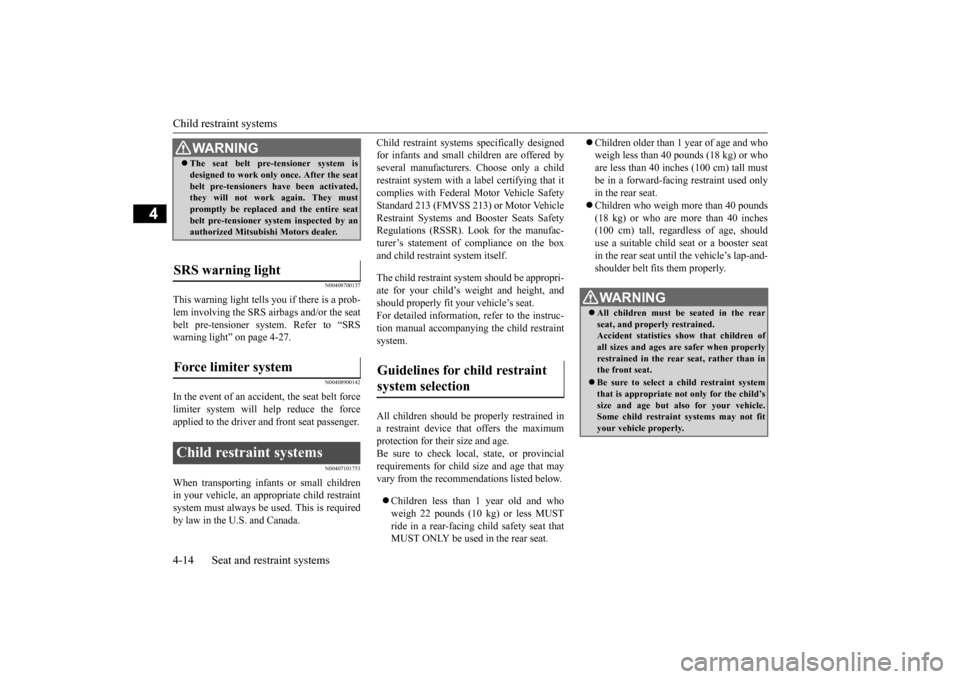
Child restraint systems 4-14 Seat and restraint systems
4
N00408700137
This warning light tells you if there is a prob- lem involving the SRS airbags and/or the seat belt pre-tensioner sy
stem. Refer to “SRS
warning light” on page 4-27.
N00408900142
In the event of an accident, the seat belt forcelimiter system will help reduce the forceapplied to the driver and front seat passenger.
N00407101753
When transporting infants or small childrenin your vehicle, an appropriate child restraint system must always be
used. This is required
by law in the U.S. and Canada.
Child restraint systems specifically designed for infants and small ch
ildren are offered by
several manufacturers. Choose only a child restraint system with a label certifying that it complies with Federal Motor Vehicle SafetyStandard 213 (FMVSS 213) or Motor Vehicle Restraint Systems and
Booster Seats Safety
Regulations (RSSR).
Look for the manufac-
turer’s statement of compliance on the box and child restraint system itself. The child restraint syst
em should be appropri-
ate for your child’s weight and height, and should properly fit your
vehicle’s seat.
For detailed information, refer to the instruc-tion manual accompanying the child restraint system. All children should be
properly restrained in
a restraint device that offers the maximumprotection for their size and age. Be sure to check local, state, or provincial requirements for child si
ze and age that may
vary from the recommendations listed below. Children less than 1 year old and who weigh 22 pounds (10 kg) or less MUST ride in a rear-facing ch
ild safety seat that
MUST ONLY be used in the rear seat.
Children older than 1 year of age and who weigh less than 40 pounds (18 kg) or whoare less than 40 inches (100 cm) tall must be in a forward-facing restraint used only in the rear seat. Children who weigh more than 40 pounds (18 kg) or who are more than 40 inches (100 cm) tall, regard
less of age, should
use a suitable child seat or a booster seat in the rear seat until
the vehicle’s lap-and-
shoulder belt fits
them properly.
WA R N I N GThe seat belt pre-tensioner system is designed to work only
once. After the seat
belt pre-tensioners have been activated,they will not work again. They must promptly be replaced and the entire seat belt pre-tensioner system inspected by anauthorized Mitsubis
hi Motors dealer.
SRS warning light Force limiter system Child restraint systems
Guidelines for child restraint system selection
WA R N I N G All children must be seated in the rear seat, and properly restrained. Accident statistics show that children of all sizes and ages are
safer when properly
restrained in the rear seat, rather than in the front seat. Be sure to select a child restraint system that is appropriate not only for the child’s size and age but also for your vehicle.Some child restraint systems may not fit your vehicle properly.
BK0212400US.book 14 ページ 2014年4月1日 火曜日 午後2時21分